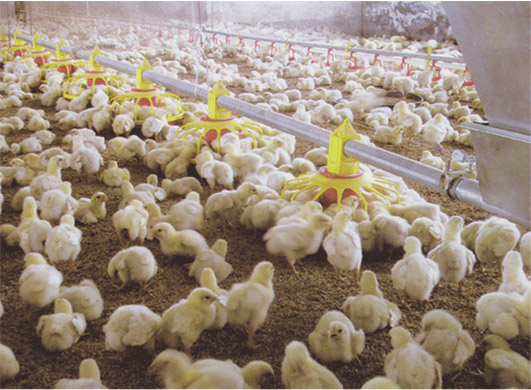Feeding nutritional requirements when using broiler cages to raise chickens
Many broiler farm cage manufacturers believe that the main task in the rearing period is to cultivate healthy, well-balanced chickens with a body weight that conforms to the normal growth curve to ensure timely production. Therefore, in production, we must pay full attention to the dietary coordination of growing chickens. The content of crude protein in the diet should be appropriately reduced, which can be gradually reduced from 18% to 19% during the brooding period to 16% to 15%.
At the same time, reduce the energy concentration in the diet. When compounding diets, low-energy feeds such as rice bran and wheat bran can be used to replace part of high-energy feeds such as corn to help exercise the stomach and intestines, improve the digestion of the feed, and make the growing chickens have a good body condition. Pay attention to supplementing vitamins and minerals. The content of calcium, phosphorus, selenium, zinc, etc. and the ratio of calcium to phosphorus in the diet should be appropriate.

During the rearing period, the feed should be changed at least twice at the age of 6-7 weeks and at the age of 16-18 weeks. There must be a transitional period for each refueling. It is not possible to change all suddenly, so that the chicken has a process of adaptation. Especially from the brooding period to the rearing period, the replacement of feed is a great turning point. The nutrient content of feed, such as crude protein content, has dropped from 18% to 19% to 15% to 16%. Changes in feed ingredients can easily change the palatability of chickens and reduce feed intake. If they are not managed well, chickens are prone to disease.
Therefore, the following methods can be adopted for feed transition. From the first 1 to 2 days of the 7th week of age, 2/3 of the breeding period feed and 1/3 of the breeding period feed are mixed and fed. For 5-7 days, use 1/3 of the brooding period feed and 2/3 of the rearing period feed to be mixed and fed. From the 8th week of age, they are completely fed with feed during the growing period.
The first kind of feed change method is relatively detailed, and it is often used when the composition of the chicks and feed species changes greatly. The third refueling method is relatively crude, and experienced farmers and broiler cage manufacturers believe that it is generally used when the composition of adult chickens and feed species changes little. The second refueling method lies between the two and has a wide range of applications.
The above are the precautions when using broiler cages to raise chickens. I hope that the above content will be useful for novice farmers.
